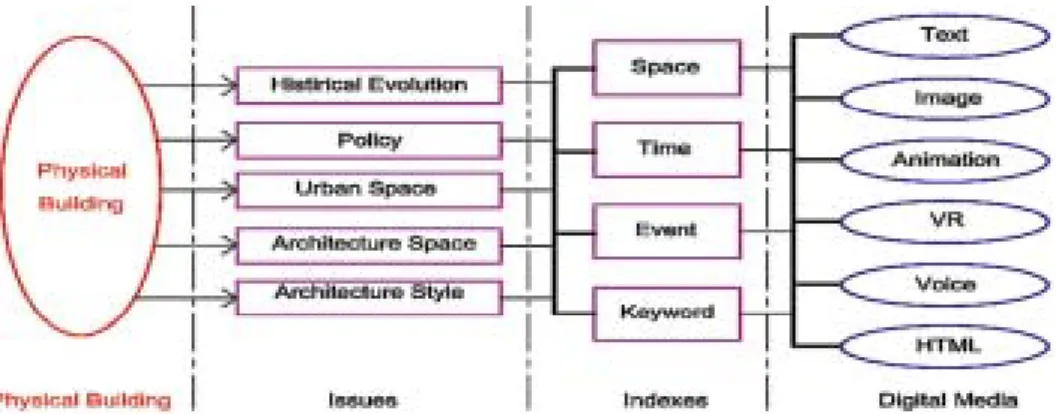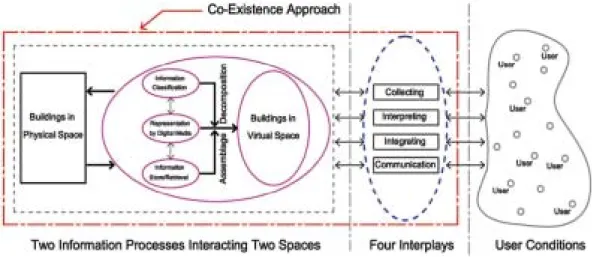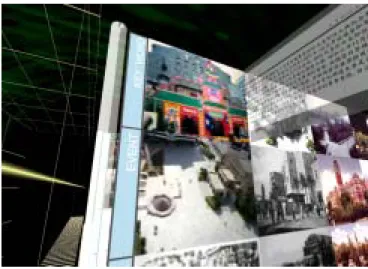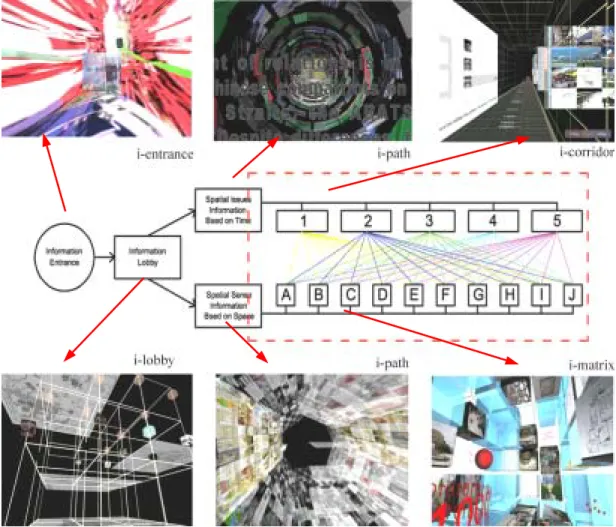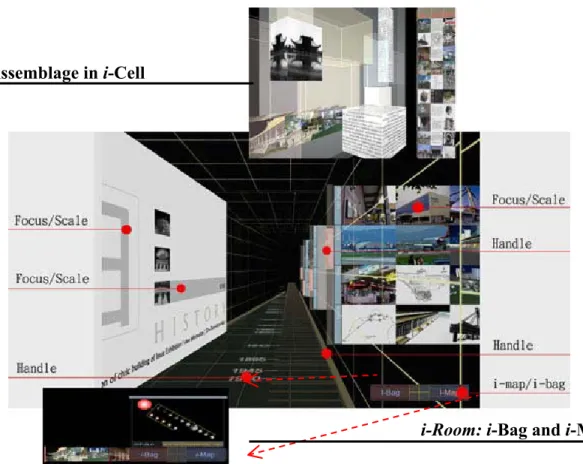行政院國家科學委員會專題研究計畫 成果報告
子計畫三:台灣公共建築時空館
計畫類別: 整合型計畫 計畫編號: NSC91-2422-H-009-3004- 執行期間: 91 年 03 月 01 日至 92 年 02 月 28 日 執行單位: 國立交通大學建築研究所 計畫主持人: 張登文 共同主持人: 張基義,葉李華 計畫參與人員: 賴怡成, 簡兆芝, 呂凱慈, 曹世緯, 林俊宏 報告類型: 完整報告 處理方式: 本計畫可公開查詢中 華 民 國 92 年 7 月 18 日
A Co-existence Approach—A Case Study for 3D Museum of
Civic Buildings in Taiwan
Teng-Wen Chang, Ih-Cheng Lai, Chao-Chin Chien, Jun-Horg Lin, Shih-Wei Tsao and Kai-Tzu Lu
Abstract
This paper presents a kind of co-existence framework for companying physical space with virtual space with a case study. The fundamental approach is to investigate the interplay between users and information in virtual space, including collecting, interpreting, integrating, and communicating. Based on this framework, we propose an information structure, which elaborates the information of our co-existence representation. The infrastructure modeled with three strategies including dynamic information components, space-time interaction and interaction between users and information is tested in representing ten historical significant civic building in Taiwan.
1 Introduction
Representing building digitally is a wide-discussed research topic. However, how to represent an existing and well-maintained building in virtual space is a hard problem. Not just the complexity of information, but also the representation itself is an arguable issue. What kind of information, thus its representation, is required when you can both access virtual space and physical space of an existing building? Will there be differences for different knowledgeable users? Furthermore, who are the users? For the question, the straightforward solution is a co-existence approach by companying the physical space with virtual space/information.
Recently, thanks to the developments of digital media technology, many researchers have attempted to use computer to virtually reconstruct existing buildings. The researches addressed such issues are: 1) Simulation: by bringing the building as real as possible under your fingerprint, this group of researches (such as Clayton et al. 1999; Sanchez et al. 1997; Braithwaite et al. 1997) simulate the building using photo-realistic rendering techniques or virtual reality techniques. This group of researches provides an important base, the visual feedback, for our research. 2) Digital media representation: find the suitable technique for representing the abstract information of buildings (Wan, Liu and Lee 2001; Datta, Chang, and Woodbury 1997; Novak 1988). This group of researches share an insight of how virtual media, thus,
digital media can be used as a representation for our purpose, and the possible co-existing relationship. 3) Augmented reality: provide virtual experience physically (Donath et al. 2001; Anders and Livingstone 2001). This group of researches thus argues that the interaction between physical and virtual space should be touchable and ubiquitous. 4) Information access: provide the possible and individual filter for accessing the numerous data of building (Inanc 2000; Fukai 1996). The main concept within this camp is to provide a mechanism for dealing with the complexity of the information.
Most of views described above have invoked two research issues—the interplay between users and the information; and the information required for that interaction. This is to say that information in virtual space should not just replicate the spatial sense of physical space. In addition, via interplay, information should provide a way to enhance the knowledge and to amplify the imagination of users. Therefore, by investigating the interplay between users and information in virtual space, we propose the co-existence framework for companying physical space with virtual space. In addition, the information structure of representation has been also tested in representing ten historical significant civic buildings in Taiwan. The result is also reported in this paper.
2 Interplay between Users and Information in Virtual Space
Interplay between users and information plays an important role in the co-existence approach. Some researchers have categorized users as novices, intermittent users and frequent users based on applicable knowledge and visiting frequency (Shneiderman, 1987; Pressman, 1992). Furthermore, two additional factors are considered for our analysis: on/off-site (when the users are visiting the virtual information when they are on or off the building site) and also 2D/3D information (as described above, 2D standard websites as long as 3D virtual worlds are needed for the experiment). This is to say that twelve different conditions of users are analyzed based on the three factors. The relevant information is shown in (Figure 1).
Figure 1. Different kinds of users are based on the above information conditions.
Besides, there are four common interplays between users and information. They are collecting, interpreting, integrating, and communicating information. These interplays along with their analysis are described in the next sessions.
2.1 Collecting information
The main interplay for users is collecting information. The information should be divided into two catalogues: the information helping them to understand the related knowledge of these buildings; and individual domain of interest such as archaeology, education, travel, design and so on. In our approach, we provide two folds of dimensional space for the need of collecting information: standard 2D space and dynamic 3D space. In standard 2D space, knowledgeable users and novices can easily collect information by a sequent linkage order. In dynamic 3D space, knowledgeable users can use different navigation methods, including world-in-hand, eyeball-in-hand and flying, walking to collect information. However, novices can go through 3D space via walking or normal click-and-fly mechanism to collect information. In addition, the collecting experience navigators have been through can build up personalized knowledge/experience. The insight from this analysis is that thoughts can be ordered and placed on the personal information space to reflect a way of thinking about the organization of their content.
Beside that, users might have the different approaches to collect information on different location: on-site or off-site. Users who are on-site always collect information to supplement and compare the experience of physical space. On the contrary, off-site navigators collect information that can provide appropriate knowledge of these buildings before they visit in physical space, or on their own requirements.
2.2 Interpreting information
Users are interpreting information based on their individual backgrounds including the profiles of their age, sex, education, motivation, goals and personalities. Standard 2D space, like usual websites, provides a typical information access by a sequent linkage order. Dynamic 3D space thus provides a no gravity environment and dynamic navigation control. For such environment, the users are encouraged to interpret information freely, and, with dynamic spatial experience that can’t be represented in physical space. Additional insight for this behavior is that the interpretation might inspire navigators the spatial imagination and un-expected means of spatial experience differently.
information combined with standard 2D space. Novices are easy to follow a sequent linkage order on the standard 2D space. Besides, another insight for this behavior is that on-site users can integrate with real experience of physical space to make the interpretation realizable. Contrarily, off-site users can have more potential to make the interpretation imaginable than on-site ones.
2.3 Integrating information
The integrating information is the essential components of Virtual space based on the nature of digital media they provide, including web-based HTML or VRML representations, or simple text-based description for individual browsing or group interaction. At the same time, navigators can easily and rapidly integrate with other information by hyper-linking different websites, where provides navigators multi-layer and diverse information.
However, users have the different approaches to integrate information for different locations. On-site users usually hyper-link/bookmark the relevant websites according to their own visiting process in physical space. Contrarily, off-site users can follow their own existing spatial experience to explore and integrate diverse information. The insight from this analysis is that dynamic 3D space provides more information space to integrate than standard 2D space regardless of knowledgeable navigators or novices. Therefore, users approach a multidimensional information exploration, where information can be non-fixed and multi-layer organization to connect related objects and scenes. In addition, such behavior can provide the necessarily orientation information for the users.
2.4 Communicating information
Information is dynamic and fluid in virtual space. Users can communicate information with their individual mental space, as well as the experience of different navigators such as Chat, Net-meeting, E-mail, download and upload information in virtual space. This interactive relationship always happens in the situation where navigators are off site. Knowledgeable navigators can skillfully utilize dynamic 3D space to communicate information with other navigators. Novices follow the typical process to communicate information based on standard 2D space. Therefore, the insight for this behavior is that navigators communicate information by their own individual spatial metaphor, where experience and knowledge can be not only transited between physical and virtual spaces, but also is shared among different users in real time. To summarize, the interplay between users and information plays a most important role to represent information in virtual space for companying physical space. Therefore, the information in virtual space is not just replicate the experience and
phenomena of physical space, but the space where users can interactively collect, interpret, integrate and communicate information.
3 The Co-existence Information Space
Information represented by data of buildings is the space in virtual space. The information space represented by the analysis described above should also respond back to the issues of navigation in virtual space. This is to say that the meaningfulness of domain data and its representation is the crucial part for implementing information representation for the navigation. Therefore, we represent data of these existing buildings following two processes—decomposition and assemblage. Furthermore, by integrating the interplay between users and information, we propose the co-existence framework to companying physical space with virtual space.
3.1 Information process: Decomposition and Assemblage
Decomposition and assemblage are the foremost information processes for representing data in virtual space. By utilizing such classification process, the data and their associated structure represent the information space for the virtual co-existence space. Also, the information processes stimulate the interplay between users and information. Come to the data representation for the virtual space, the available data types are still digital media such as text, 2D images, 3D models, animation, and acoustic media to represent data of building. The composition of many digital media should relate to the means of domain data, thus the design knowledge, relevant to the existing buildings. The exemplary issues are historical background, programming, spatial sense, construction technology, construction material, etc (Figure 2).
Figure 2. The diagram shows the decomposition process from physical building, issues, and indexes to digital media.
3.2 The co-existence framework
Our co-existence framework is basically composed with two constituents. They are 1) two information processes: decomposition and assemblage representing the information space for the virtual space to interact physical space; 2) four interplays: four interplays (collecting, interpreting, integrating and communicating) providing different user conditions for users to interact information in virtual space. These two constituents constitute the co-existence approach for companying physical space with virtual space. Under this framework, we implement the information structure using ten historical significant civic buildings in Taipei as the example. The outcomes as well as the possible impacts of the case are documented in the following sessions.
Figure 3. The diagram shows the co-existence framework for companying physical space with virtual space.
4 The Information Space of Existing Civic Buildings in Co-existing Virtual Space
For testing the approach of co-existing spaces and representation of information, we model the information space using ten historical significant civic buildings in Taipei. The selection criteria are based on four time periods in Taiwanese modern history, including Ching Dynasty, Republic, Japan Occupation and Modern era. Each building has attained its wholeness through years or centuries of acculturation, and still exists in its own way in the modern Taipei city. Based on an individual spatial structure, we apply the framework as the system called i-Room (Chang and Lai, 2003) that incorporates two processes, and four interplays discussed above. And, we implement such co-existing space with 3D navigation and representation based on a 3D virtual platform called Muse (Muse 2003). The information structure is modeled with three strategies: dynamic information components, space-time interaction and interaction
between users and information
4.1 Dynamic Information components
Each civic building has its own identity and specific information, which consist of several issues and their indexes in virtual space. Therefore, ten civic buildings are decomposed into diverse components, five issues and four indexes, and represented by digital media. Five classified issues are 1) historical evolution, 2) policy, 3) urban space, 4) architectural composition and 5) architectural style. Each issue composes of four indexes, including space, time, event and keyword. The classification is shown as (Figure 2). With available information, there are over 500 decomposed components that form the co-existing information space. As well, each component combined with appropriate digital media has been representing onto two information spaces—standard 2D space (Figure 4) and dynamic 3D space (Figure 5) in Muse sites.
Figure 4. The image shows standard 2D information space.
4.2 Space-Time interaction
The interacting of co-existing space within i-Room is to interact with the dynamic information landscape built by lots of decomposition components. In addition, the decomposition components are based on two axes of ‘space’ and ‘time’, and are hyper-linking each others based on the user analysis described above. Hence, navigators explore through the complex cross network built by co-existence of physical space and virtual space. The relation is shown in (Figure 6). The spatial structure shown in the experiment is composed with 16 Muse sites, and each site is represented by its individual spatial metaphors such as i-entrance, i-lobby, i-metric cube, and i-corridor. Besides, the relationships among these virtual sites of civic buildings are connected by two other spatial metaphors i-paths.
Figure 6. The information structure is composed with diverse spatial components metaphorically based on interaction between space and time. Symbols (1-5) represent five spatial issues, and symbols (A-J) represent ten civic buildings.
4.3 An interaction between users and information
The other process is called assemblage. Users can assemblage these decomposed components to reflect a way of thinking about the re-organization content of buildings according to their own interesting and background. In addition, users can exchange personal information with the others and download the assemblage information in real-time. Therefore, the mechanism of assemblage is composed with two layers of interaction: 1) between user and information, and 2) between user and other users. Furthermore, each interaction can be represented by additional metaphor in i-Room framework: i-Bag, i-Map, and i-Cell for assemblage (Figure, 7).
Figure 7: The image shows different constitutes within i-Room system.
5 Evaluation and Findings
By evaluating the interplay in this case, there are some findings can be addressed here. In standard 2D information space, most of users easily navigate information by following the hierarchy linkage. Also, it enhances users more easily to understand the relationship between information. This kind of interplay is suitable for novice and on-site users. However, the 2D information space is more limited and passive to interplay between users and information, and not humane for users to interact
Assemblage in i-Cell
information. Within this space, the interplay more focuses on collecting information than interpreting, integrating and communicating.
3D dynamic information space provides more dynamic and active interplay than 2D information space. Most of users tend to explore information by interpreting, integrating and communicating besides collecting. In particular, it inspires off-site and knowledgeable users to play with information. However, most of users always get lost in 3D information space. Also, there are more complex operations to interplay between users and information. Therefore, orientation and humane interface is the key for interplay in 3D information space.
6 Conclusion and Future Work
In conclusion, this paper provides a basic understanding of how to interact with users and information to highlight the co-existence relationship between physical space and virtual space, especially on the virtual space. The interactive relationships between users and information are four behaviors—collecting, interpreting, integrating and communicating. Each behavior presents different meanings to users in virtual space. Therefore, information is decomposed and reassembled to combine with the specific interests of users, overview the existing buildings and define their own programs. When the potential uses of virtual space in real world, the spatial experience and knowledge can be affected by the information technology quickly, and the influence will be visible.
The demonstration project provides some directions for future development in the co-existence relationship between physical space and virtual space. However, there are two issues should be more in-depth studies for our future work. They are 1) human-computer interface: enhances speed of learning and performance between users and information; 2) social interaction: explores new form of interaction for exchanging idea and thoughts in addition to current communication technology.
References
Anders, Peter and Livingstone, Daniel (2001) Reinventing the Discourse - How Digital Tools Help Bridge and Transform Research, Education and Practice in Architecture, the Proceedings of 21th Conference of the Association for Computer-Aided Design in Architecture, Buffalo (New York), pp. 350-355 Braithwaite, G., Radford, A., Huang, E., Chang, T.-W., Jones, D., Woodbury, R., and
Sweeting, R. (1997). The computer modelling of development proposals: A routine part of development control. In Liu, Y.-T., editor, CAADRIA 97, volume
2, pages 123-132, Hsinchu, Taiwan. Computer Aided Architecture Design Research in Asia, National Chiao Tung University.
Clayton, M.J., Warden, Robert B., Parker, Th.W.(1999). Virtual Construction of Architecture Using 3D CAD and Simulation. Media and Design Process, the Proceedings of ACADIA ’99, Salt Lake City, pp. 316-324
Chang, Teng-Wen and Lai, Ih-Cheng (2003). Reflective Navigation in Information Landscape—A 3D Museum for Civic Buildings, the Proceedings of 8th Conference on Computer Aided Architectural Design Research (CAADRIA), Thailand.
Datta, S., Chang, T.-W., and Woodbury, R. F. (1997). Describing temple cellas in SEED-Config. In Liu, Y.-T., editor, CAADRIA 97,volume 2, pages 367-376, Hsinchu, Taiwan. Computer Aided Architecture Design Research in Asia, National Chiao Tung University.
Donath, D., Beetz, J., Grether, K., Petzold, F. and Seichter, H. (2001). Augmented Reality Techniques for Design and Revitalization in Existing Built Environments, Reinventing the Discourse - How Digital Tools Help Bridge and Transform Research, Education and Practice in Architecture, Proceedings of 21th Conference of the Association for Computer-Aided Design in Architecture, Buffalo (New York), pp. 322-329
Fukai, Dennis (1996) A World of Data: An Animated Construction Information System as a Virtual Hypergraphic Environment, Design Computation: Collaboration, Reasoning, Pedagogy. ACADIA Conference Proceedings, Tucson (Arizona / USA), pp. 267-274
Inanc, B. Sinan (2000). Casebook: An information retrieval system for housing floor plans, the Proceedings of 5th Conference on Computer Aided Architectural Design Research (CAADRIA), Singapore, pp 389-398.
Muse (2003). http://www.musecorp.com/.
Novak, Marcos J. (1988). Computational Composition in Architecture.Computing in Design Education, ACADIA Conference Proceedings, Ann Arbor (Michigan / USA), pp. 5-30
Pressman, Roger S. (1992). Software Engineering-A Practitioner’s Approach, 3rd Edition, McGraw-Hill. Press
Sanchez, Santiago, Zulueta, Alberto and Barrallo, Javier (1997). CAAD and Historical Buildings: The Importance of the Simulation of the Historical Process.
Challenges of the Future, 15th eCAADe Conference Proceedings, Vienna (Austria)
Shneiderman, B. (1987). Designing the User Interface. Addison-Wesley
Wan, P.-H. Liu, Y.-T. and Lee, Y.-Z. (2002). The Co-existence between Physical Space and Cyberspace - A Case Study, Connecting the Real and the Virtual - design e-ducation, 20th eCAADe Conference Proceedings, Warsaw (Poland), pp. 597-602.
